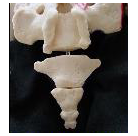Is it Tailbone Pain?
Do you have TAILBONE PAIN (COCCYX PAIN)?
|
How to tell if you have TAILBONE PAIN (coccyx pain)
by Dr. Foye… www.TailboneDoctor.com
Introduction
How do you know if your pain is coming from a sore tailbone (coccyx)? If you have pain, soreness, discomfort, aching, or other symptoms in the region of the lower back, buttocks, etc., you may be unsure if the symptoms are coming from the tailbone or now. In my medical career as a physician who has treated at least hundreds of patients with tailbone pain, I commonly see patients who have suffered for years without knowing what was causing their pain. The steps below may help you and your doctor determine whether the pain is coming from the tailbone (coccyx).
Instructions
Difficulty: Moderately Challenging
Steps
Step One
Location: Pay attention to where the worst area of pain seems to be. The tailbone is at the lowest (bottom) tip of the spine. Tailbone pain is typically in the midline, between the right and left buttock cheeks, slightly above the anus. One way to educate yourself on the location of the tailbone is to look at images on the internet (see the links at the bottom of this page).
Step Two
Injury: Try to remember any injury or trauma you had before the pain started. The tailbone can be injured, bruised, fractured (broken, chipped), by trauma such as falling onto the tailbone. Sports injuries could include falls onto the tailbone while skateboarding, skiing, snowboarding, ice skating, or playing basketball, football, etc. Prolonged sitting can also cause tailbone pain, such as on a long trip or while cycling (sitting on a bike). Sometimes tailbone pain can begin after no trauma or injury to the region at all.
Step Three
Exacerbating factors: Notice what makes it worse. Tailbone pain is typically worse while sitting. In particular, sitting and then leaning slightly backwards puts pressure (body weight) on the tailbone, worsening the pain. The pain may also be worse for a few moments when you first stand up from sitting. A coccyx cushion may help.
Step Four
See your physician: Have your doctor evaluate your symptoms and perform a careful physical examination. Ask your doctor whether there are any tests that might help confirm what is causing your pain.
Step Five
If your doctor is not experienced at evaluating or treating tailbone pain, seek a second opinion from a physician with more expertise in this area.
Overall Tips & Warnings
- For more information on Tailbone pain, please see TailboneDoctor’s other articles on eHow, or go to www.TailboneDoctor.com
- WARNING: This information is intended to be educational and is NOT to be considered as medical advice. This information is NOT a substitute for direct medical care from a physician who evaluates you in person.
- WARNING: coccyx pain can sometimes be due to very serious underlying medical conditions, so it is important to seek in-person evaluation by a medical professional.
- WARNING: Many physicians and other health providers have little or no experience in evaluating or treating tailbone pain or coccyx injuries. If you are not satisfied with the first physician you see, then seek medical attention from a specialist with experience in treating tailbone pain.
|
| |
RELATED WEBSITES AND WEB-PAGES:
Tailbone Pain (Coccyx Pain) Doctor / PhysicianTailbone Pain (Coccyx Pain) Free Review Article at eMedicine
Tailbone Pain (Coccyx Pain) Publications
Tailbone Pain (Coccyx Pain) Information
Tailbone Pain (Coccyx Pain) Dr. Foye
Tailbone Pain (Coccyx Pain) Injections
Tailbone Pain (Coccyx Pain) New Jersey (NJ)
Tailbone Pain (Coccyx Pain) New York (NY)
Tailbone Pain (Coccyx Pain) New York City (NYC)
Tailbone Pain (Coccyx Pain) Pennsylvania (PA)
Tailbone Pain (Coccyx Pain) Connecticut (CT)
Tailbone Pain (Coccyx Pain) Images, Xrays, MRI & Photos
Dr. Foye’s Listing on Spine Universe
Information on Tailbone Pain (Coccyx Pain) Relief
eMedicine article on Tailbone Pain (Coccyx Pain)
Testimonials from Patients with Tailbone Pain (Coccyx Pain)
Dr. Foye’s Faculty Profile at New Jersey Medical School
Tailbone Pain (Coccyx Pain) images on Flickr
Dr. Foye’s “How to” articles on Tailbone Pain:
++++++++++++++++++++++++++++++++
How to tell if you have a DISLOCATED TAILBONE (COCCYX DISLOCATION)
How to tell if you have a BROKEN TAILBONE (FRACTURED COCCYX)
How to tell if you have TAILBONE PAIN (COCCYX PAIN)
How to describe TAILBONE PAIN (COCCYX PAIN)
How to Pick a COCCYX CUSHION (TAILBONE CUSHION) for Coccyx Pain (Tailbone Pain)
How to know if your MRI included the TAILBONE (COCCYX MRI)
How to Cope with TAILBONE PAIN DURING PREGNANCY
How to SIT with TAILBONE PAIN
How to Decide about Tailbone Removal (Coccyx Removal Surgery, Coccygectomy) for Tailbone Pain
++++++++++++++++++++++++++++++++++++++++++++++++++++++++++++++++ |
| |
Click here
to get a free
Newsletter on Tailbone Pain
|
Patrick Foye, M.D.,
Director of the Coccyx Pain Center,
PM&R at Rutgers
New Jersey Medical School,
90 Bergen St,
DOC Suite 3100,
Newark, New Jersey,
USA, 07103For an appointment, call:
973-972-2802 |
| TAILBONE PAIN
Copyright 2006, 2007, 2008, 2009, 2013.
Patrick Foye, M.D.
www.TailboneDoctor.com
and
www.Tailbone.info
and
www.TailbonePain.net
Disclaimer:
This web site is for
general informational purposes only.The information should not be
considered as medical advice.The information is not a substitute for appropriate in-person care
by a physician
with expertise in evaluating
and treating tailbone pain.This website
is not meant to represent
official views
of any university,
medical school,
hospital, etc.
Effective July 2013:
New Jersey Medical School is part of Rutgers, The State University of New Jersey.
|
|
| |
|
